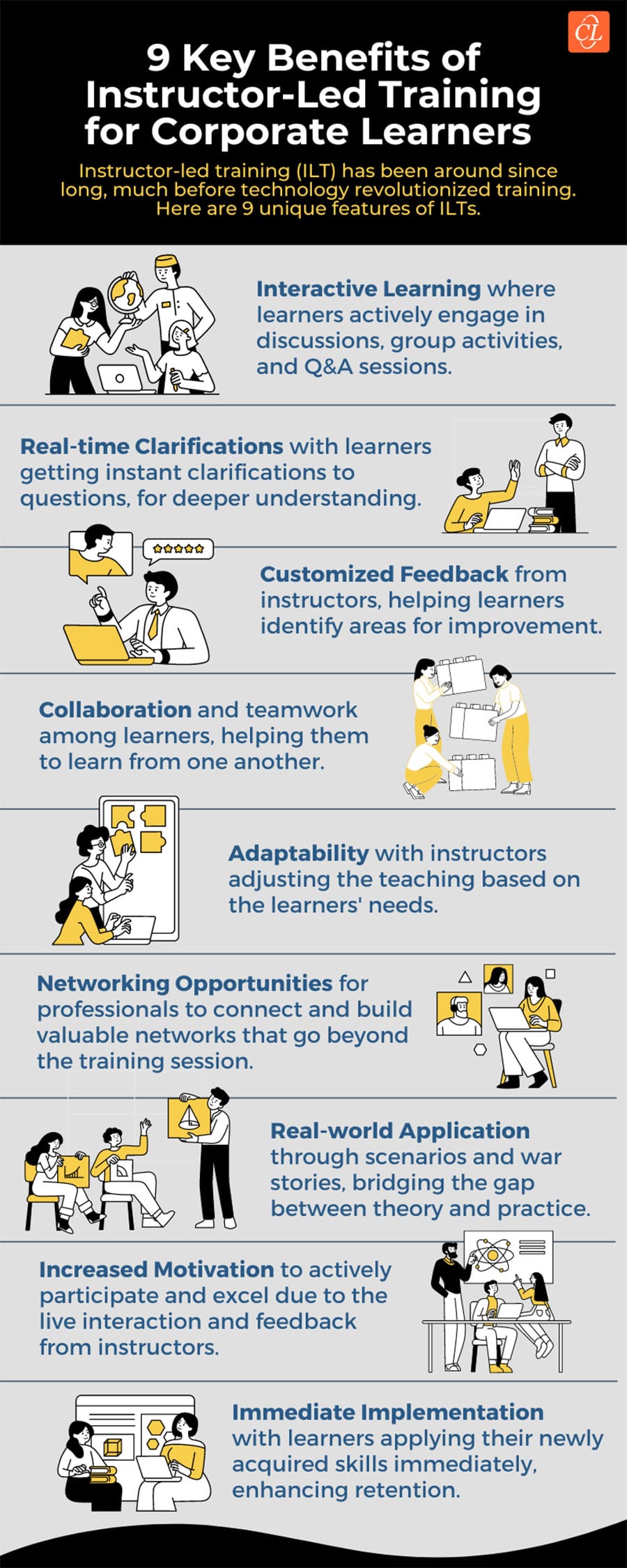How is ILT’s Comeback Changing Training Dynamics? [Infographic]
![How is ILT’s Comeback Changing Training Dynamics? [Infographic] How is ILT’s Comeback Changing Training Dynamics? [Infographic]](https://blog.commlabindia.com/hubfs/blogs/corporate-training-ilt-comeback-info.jpg)
Why, despite the constant progress in technology, is Instructor Led Training (ILT) experiencing a noticeable comeback? Is this shift back to traditional ILT methods just a sentimental nod to the roots of learning, or does it signify a surprising adaptation to the evolving landscape dominated by technology? Could the increasing demand for ILTs from organizations globally be a response to the changing dynamics of the modern world, which seemingly favors technology? Let's dig into why ILTs are making a comeback and what it means for the future of learning.
How is ILT Making a Comeback?
ILT has historically been the prime part of Learning and Development (L&D) initiatives, embraced by organizations worldwide for its effectiveness in imparting knowledge and skills. However, the landscape of training has evolved with the advent of digitalization and technological advancements. The shift towards digitalization has prompted organizations to adapt and modernize their corporate training methods to leverage the benefits of eLearning.
The COVID-19 pandemic accelerated this transition as organizations were compelled to pivot from ILT to eLearning due to social distancing measures and remote work arrangements. However, as the pandemic recedes and life gradually returns to normalcy, organizations are faced with the challenge of striking a balance between in-person and virtual training options.
While eLearning offers flexibility and scalability, allowing learners to access training anytime, anywhere, ILTs are valued for their interactivity, engagement, and ability to foster meaningful connections between learners and instructors. L&D professionals recognize that certain kinds of training, such as soft skills development, leadership training, and team-building activities, are best suited for ILTs due to their immersive nature and tangible impact on business outcomes.
→ Download Now: ILT to Digital Learning [Case Study]
Here's an infographic highlighting the benefits of ILT, have a quick look!
As organizations navigate the post-pandemic landscape, many are opting to reintroduce ILTs alongside online learning initiatives to create a blended learning approach that combines the best of both worlds. Blended learning allows organizations to leverage the strengths of ILTs for interactive and high-impact training sessions, while also harnessing the flexibility and accessibility of eLearning for self-paced learning and knowledge reinforcement.
What’s the role of ILT in the Future of L&D?
The role of ILT in the future of L&D is poised to undergo a transformation, reflecting the evolving needs and preferences of learners. While traditional classroom training has long been a cornerstone of L&D initiatives, the future landscape will require a nuanced approach that embraces the strengths of both physical and digital learning modalities.
In this future vision, classroom training retains its significance by serving as a pivotal component in the broader learning journey. It will play a crucial role in facilitating live application and interaction, providing learners with valuable opportunities for hands-on practice, real-time feedback, and collaborative learning experiences. Classroom sessions will serve as dynamic forums where learners can engage with instructors and peers, fostering deeper understanding and skill mastery.
However, this future outlook also acknowledges the current trend of blending ILT with technology to enhance learning outcomes. Virtual classrooms, interactive simulations, and online modules will complement classroom sessions, providing learners with a diverse range of learning experiences tailored to their individual needs and preferences. Looking ahead, the future of L&D will involve a strategic approach to selecting the most effective learning strategies for each aspect of the learning journey.
Is the Resurgence of ILT a Blessing or Challenge for Modern Corporate Training?
The resurgence of ILT training sparks a debate within the realm of corporate training—is it a blessing or a challenge? For some, particularly those advocating a holistic learning ecosystem, it's perceived as a blessing. The return of ILT is seen as a restoration of balance, bringing back the crucial elements of collaboration, interactive learning, and unique advantages that physical interaction offers.
However, instructor-led training is not without its challenges. From a cost perspective, it poses a significant hurdle. It typically demands larger budgets, and in the context of today's evolving landscape, it may be viewed as less sustainable. The need for physical infrastructure, travel expenses, and resource allocation often leads organizations to reassess the viability of extensive classroom-based initiatives.
In navigating the corporate learning landscape, striking a balance between the collaborative advantages of traditional instructor-led training and the cost-effectiveness of online methods becomes important. The key lies in embracing a blended learning approach that leverages the strengths of both, ensuring that learning initiatives are impactful, sustainable, and tailored to the diverse needs of learners.
The Path Ahead
The re-emergence of ILT amidst technological advancements reflects a notable trend in the learning landscape. Organizations globally are increasingly opting for ILTs, recognizing their value alongside digital learning methods. This shift highlights the ongoing evolution of learning approaches and emphasizes the enduring relevance of traditional training methods in a rapidly changing world. As businesses navigate the future of work, aligning L&D initiatives with strategic business objectives becomes crucial. To provide insights on that, our eBook can be your handy guide with actionable insights and strategies to bridge the gap between L&D efforts and organizational goals, ensuring a cohesive and effective approach to workforce learning and development in the digital era.







![Challenges in Converting Your ILT Courses to E-Learning [Infographic]](https://blog.commlabindia.com/hubfs/Imported_Blog_Media/converting-ilt-to-elearning-challenges-infographic.png)